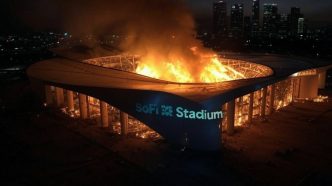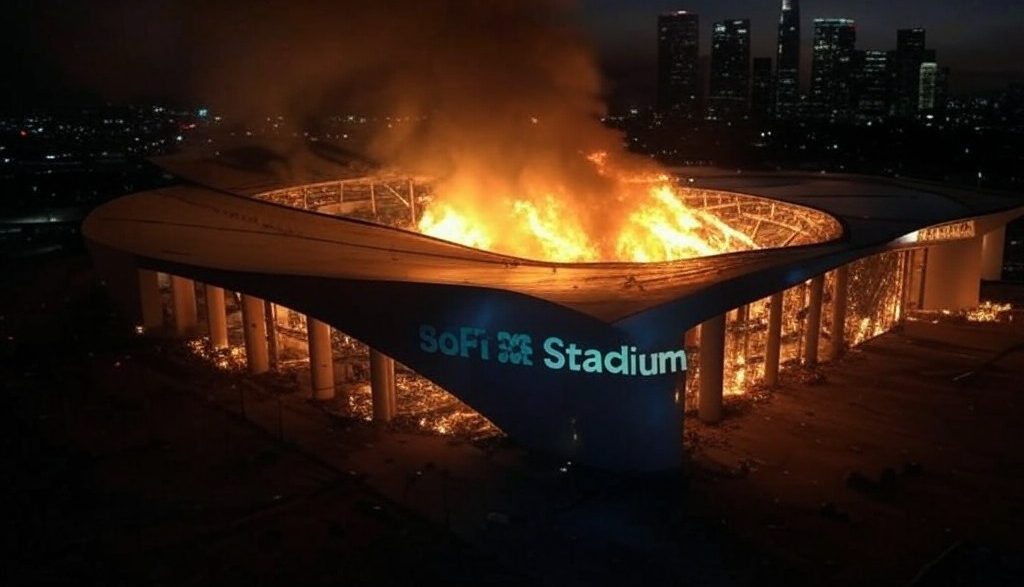The NFL’s presence in Los Angeles has brought football back to one of America’s most vibrant cities, but a growing concern lingers over the region: wildfires. With climate change escalating the frequency and intensity of these blazes, questions are beginning to surface about the long-term sustainability of having two NFL teams in an area so prone to environmental disasters. Could relocating the Chargers and Rams to less volatile locations be the best way forward?
A Growing Threat to SoFi Stadium
SoFi Stadium, the $5 billion architectural marvel that houses both the Chargers and Rams, sits in the heart of Inglewood—a bustling urban area seemingly insulated from the immediate dangers of wildfires. However, the unpredictability of these disasters means that no area is entirely safe. Los Angeles County has seen its share of devastating fires that, while not yet directly threatening SoFi, could disrupt events, jeopardize safety, and complicate operations in the future.
The economic ripple effects of wildfire seasons in California are immense, from power outages to air quality warnings. Even if SoFi itself remains untouched, the broader community impact could make hosting NFL games a logistical nightmare.
The Case for Relocation
Moving the Rams and Chargers might seem extreme, but it’s not without precedent. Teams have relocated for less significant reasons—stadium disputes, market size, or even the allure of a better deal elsewhere. A move driven by environmental safety could actually position the NFL as a forward-thinking league willing to address the realities of climate change.
Relocation would also provide an opportunity to expand into untapped or underserved markets. Cities like San Antonio, Portland, or even Salt Lake City could offer enthusiastic fan bases, modern facilities, and lower environmental risks. Such moves would preserve the NFL’s game-day experience without the looming specter of natural disasters.
Challenges of a Move
Of course, leaving Los Angeles isn’t as simple as packing up and heading elsewhere. The Rams and Chargers returned to LA for its massive market potential, sponsorship opportunities, and cultural significance. Relocating would mean walking away from a thriving metropolis, a cutting-edge stadium, and the growing fan engagement that’s finally taking root.
Moreover, LA has proven it can weather environmental challenges. The city’s infrastructure is among the most resilient in the world, and SoFi Stadium was built with modern safety standards in mind. Wildfire risk, while real, might not be enough to justify a costly relocation that could alienate loyal fans.
Can Los Angeles Adapt?
The solution may not be a full-scale move but rather proactive measures to mitigate risk. Enhanced emergency protocols, strategic air quality systems, and community partnerships to combat wildfire risk could ensure that the Chargers and Rams remain a staple of Los Angeles sports for years to come.
Additionally, staying in LA allows both teams to remain part of the solution. The NFL’s resources could fund wildfire prevention efforts, community relief programs, and public awareness campaigns, helping address the root causes of these natural disasters.
What’s at Stake
Relocation would undoubtedly be a bold and controversial move, but the NFL has always been a league of innovation. Protecting the integrity of its teams, players, and fans must remain a top priority. If the wildfire threat grows more immediate, moving the Rams and Chargers could shift from a far-fetched idea to a necessary decision.
For now, the Chargers and Rams remain firmly planted in Los Angeles, but as the landscape of climate change evolves, so too might the conversation about their future. Whether they stay or go, the NFL and its teams must adapt to the realities of an increasingly unpredictable world.








